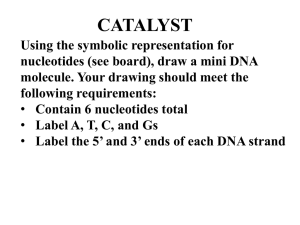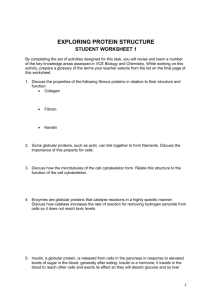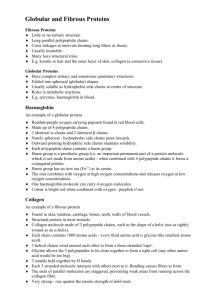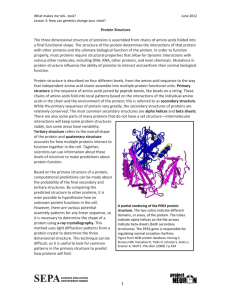ANSWERS TO REVIEW QUESTIONS – CHAPTER 02
advertisement
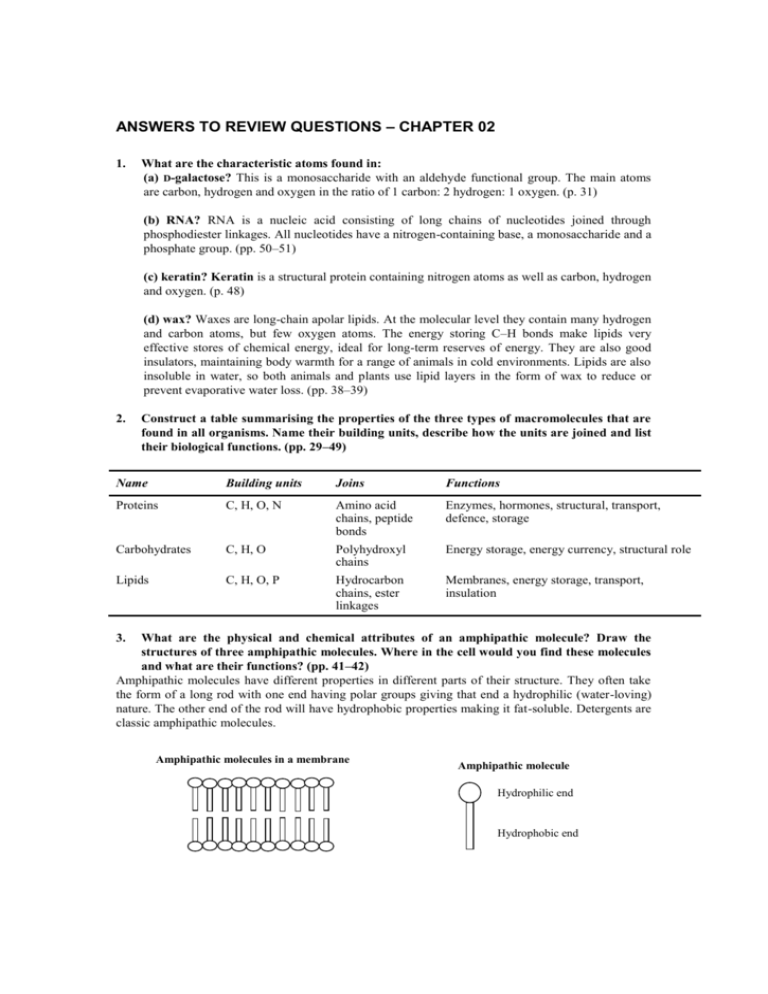
ANSWERS TO REVIEW QUESTIONS – CHAPTER 02 1. What are the characteristic atoms found in: (a) D-galactose? This is a monosaccharide with an aldehyde functional group. The main atoms are carbon, hydrogen and oxygen in the ratio of 1 carbon: 2 hydrogen: 1 oxygen. (p. 31) (b) RNA? RNA is a nucleic acid consisting of long chains of nucleotides joined through phosphodiester linkages. All nucleotides have a nitrogen-containing base, a monosaccharide and a phosphate group. (pp. 50–51) (c) keratin? Keratin is a structural protein containing nitrogen atoms as well as carbon, hydrogen and oxygen. (p. 48) (d) wax? Waxes are long-chain apolar lipids. At the molecular level they contain many hydrogen and carbon atoms, but few oxygen atoms. The energy storing C–H bonds make lipids very effective stores of chemical energy, ideal for long-term reserves of energy. They are also good insulators, maintaining body warmth for a range of animals in cold environments. Lipids are also insoluble in water, so both animals and plants use lipid layers in the form of wax to reduce or prevent evaporative water loss. (pp. 38–39) 2. Construct a table summarising the properties of the three types of macromolecules that are found in all organisms. Name their building units, describe how the units are joined and list their biological functions. (pp. 29–49) Name Building units Joins Functions Proteins C, H, O, N Amino acid chains, peptide bonds Enzymes, hormones, structural, transport, defence, storage Carbohydrates C, H, O Polyhydroxyl chains Energy storage, energy currency, structural role Lipids C, H, O, P Hydrocarbon chains, ester linkages Membranes, energy storage, transport, insulation 3. What are the physical and chemical attributes of an amphipathic molecule? Draw the structures of three amphipathic molecules. Where in the cell would you find these molecules and what are their functions? (pp. 41–42) Amphipathic molecules have different properties in different parts of their structure. They often take the form of a long rod with one end having polar groups giving that end a hydrophilic (water-loving) nature. The other end of the rod will have hydrophobic properties making it fat-soluble. Detergents are classic amphipathic molecules. Amphipathic molecules in a membrane Amphipathic molecule Hydrophilic end Hydrophobic end Two kinds of amphipathic lipids are found in biological membranes. Phospholipids and glycolipids both have hydrophobic ‘ends’ composed of hydrocarbon chains. The hydrophilic end of phospholipids has a polar phosphate group attached. In glycolipids, the hydrophilic end is composed of sugars (carbohydrates). 4. (a) What is the R-group of an amino acid? (pp. 43–47) The R-group of an amino acid is one of its most important distinguishing features. All amino acids have an amine and a carboxylic acid group but the R-group provides the distinctive properties of acidity, polarity, shape and pattern of electron density. (b) Draw an example of one amino acid with a simple R-group and one with a complex Rgroup. Identify the functional groups on the two amino acids. (pp. 43–47) Carboxylic acid group Amino group O H2N CH O H2N CH C C OH CH 2 OH H R-groups Tryptophan HN Glycine 5. Distinguish between the structures and functions of fibrous proteins and globular proteins. (pp. 43–47) Fibrous and globular proteins can be distinguished by their structures. The primary and secondary structures of proteins refer respectively to (1) the sequence of amino acid monomers and (2) the bending and folding of the amino acid chain. The tertiary structure of a protein refers to the overall shape of the protein molecule and this is generally described as fibrous (rod shaped) or globular (spherical). The shape of globular proteins is determined by the folding of the amino acid chain arranged such that hydrophobic side (or R-group) chains are buried within the centre of the glob and away from interactions with water molecules. The function of fibrous proteins is mainly structural. Keratins are a protein family, which comprises a significant proportion of hair, nail, horn and feathers. Another fibrous protein family is the collagens that make up a major part of connective tissue. The function of globular proteins is mainly enzymatic (catalytic) and comes about through folding of the surface into distinctive shapes complementary to the substrates upon which the protein acts. 6. Compare the structure and functions of DNA and RNA. (pp. 50–51) DNA is a double helix. It has two ‘strands’ of a sugar phosphate backbone bent into a helical shape. Attached to the strands are the nitrogenous bases. These bases interact by hydrogen bonding with those on the other strand, which hold the two strands together. RNA is a single strand helix with a different class of sugar molecule in the strand. The order of the different bases along the sugar phosphate strand in DNA is a code that controls the morphology and functions of the cell. Transcriptions of that code are made by the cell synthesising RNA as a complementary copy of the DNA strand.

